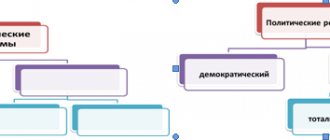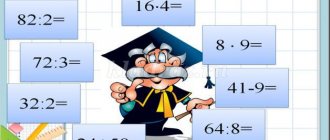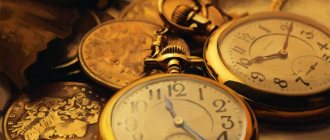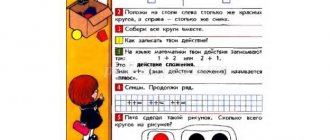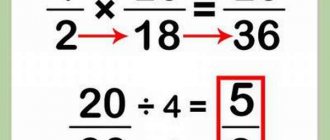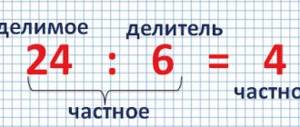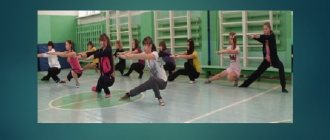Download material
so UNT / Lesson developments / Lessons in Mathematics
Notes for the mathematics lesson “Number and figure 3. Triangle” 1st grade
09/12/2015 4458 506 Zhuk Yulia Viktorovna Purpose of the lesson: to introduce the number and number 3, composition and expression. Objectives: Show how to obtain the number 3 by separating similar objects from a group according to two distinctive features. Learn to write the number 3. Develop attention, thinking, speech. Foster a love for animals and the environment. Foster cognitive activity and independence. Lesson type: learning new teaching methods: reproductive, practical, comparative. Forms of training: exercises, training tasks Types of knowledge control and feedback: individual, frontal survey. Equipment: tables, notebooks with a printed base, counting material, fans, presentations: “Funny Counting”, “Writing Numbers”.
During the classes
I. Organizational moment. II. Updating knowledge. Verbal counting. (Working with fans) Counting in a “chain” from one to 10 in forward and reverse order. Show on the fans the previous number, the next... Name the “neighbors” of the numbers 4, 6, 9. Which number comes first when counting?” [One.] What number comes after it?” (Two.) Name the numbers in order from 1 to 5, from 3 to 6, from 7 to 10, etc. Exercises to compare two groups of objects; equalization (two ways). Open 5 red circles on your strip in one row, and 6 blue circles in the second row. —Which circles are bigger: red or blue? - There are fewer of them. How can I make the number of red and blue circles equal?
“Fun tasks”
Our cat has five kittens, sitting side by side in a basket. And the neighbor's cat has three! So cute, look! Help me count, what is three and five?
Seven geese set off on their journey. The two decided to rest. How many are there under the clouds? Count it yourself, children.
The apples in the garden are ripe, We managed to taste them, Five ruddy, pouring ones, Two with sourness. How many are there?
The hedgehog brought three apples from the garden. He gave the most rosy thing to Belka. The squirrel received a gift with joy. Count the apples on the hedgehog's plate!
III. New material.
1. Introduction of number and figure 3. Three is a snake charmer. He came out with his pipe. A snake dances in front of him - the tail is hooked, the neck is arched. Look at the snake - It’s the number three! V. Danko
He has colored eyes, Not eyes, but three lights, He looks at me with them in turn. Traffic light (Conversation about traffic rules)
2. Setting the goal of the lesson. — Formulate the topic of the lesson.
Before us is the number three. Take a closer look. Draw, my friend, two flower petals. The petals are looking to the right: Don’t hold your hands. Stop the pencil! The result is number three! OR And look at this, the number three appears. Three - the third of the icons - Consists of two hooks.
— What is connected with the number 3 in your life? — What do you know about the number and figure 3? — What works of art are associated with the number 3?
How many months are there in winter, In summer, in autumn, in spring, How many eyes do traffic lights have, Bases on a baseball field, Edges on a sports sword And stripes on our flag, No matter what anyone tells us, Numbers know the truth...
3. Familiarity with the method of obtaining the number 3 is based on the children’s performance of practical work. The teacher asks the student to place one blue triangle and one red triangle on the typesetting canvas. - How many triangles are there? — Place a card next to it indicating the number of triangles. - Add another triangle to these triangles. - How many triangles are there? “How did you get three triangles?” A similar practical exercise is performed with children sitting at the sledge under the dictation of the teacher. - Count from 0 to 3 and back. Pay attention to the location of the number 3 relative to the numbers 0, 1 and 2, the designation of the number 3.
IV. Physical exercise.
The sun looked into the crib... One, two, three, four, five. We all do exercises, We need to sit down and stand up. Stretch your arms wider, One, two, three, four, five. Bend over - three, four, and jump in place. On the toe, then on the heel. We all do exercises.
V. Consolidation. 1. Working with the textbook (pp. 31-32). Tasks 1, 2 and 3. Based on the plot of the picture, children explain how the equalities 2+1=3, 3-1=2 are composed. Children obtain the number 3 in three ways: by counting objects, by adding in the process of measuring length. The elements of triangle and angle are repeated. Task 4. The numbers 2 and 3 are compared. Children read entries using the signs “greater than” and “less than”. Task 5. A suitable drawing is selected for the recording. NZ. You should compare the combs, eyes, beaks, flowers, petals, wings, and legs of chickens. Etc. In the first row on the left and in the second row in the middle, the chickens are the same.
2. Work in a notebook (p. 24). Task 1. Students find the numbers corresponding to the number of toys and connect them with a line. Task 2. Practicing the ability to write the number 3 and repeating the writing of the numbers 0, 1, 2 and action signs. Task 3. Find and circle the indicated lines in the pictures.
VI. Lesson summary. — What topic did you study in today’s lesson? — What does a person have to do with the number 3 and the number 3? — Guess the riddle: “Three people plow with one plow?” - What does this riddle mean? — What time does the clock show?
See the downloadable file for the full text of the material.
The page contains only a fragment of the material.
At what age does the process of memorization occur best?
Children's brains quickly absorb any information. Up to 7 years of age, the amount of data that a person receives in his entire life is remembered. It is necessary to use the abilities of the brain at this age.
Playful learning can begin from an early age. The world of numbers opens up for a little person by counting fingers. From the age of 4, the requirements increase; exercises aimed at developing fine motor skills are necessary. The adult’s task is to help him not miss this moment.
Factors influencing memorization:
- emotions that are evoked by the information presented;
- teaching methods;
- the meaning of the material, its accessibility for understanding;
- the child must understand why he needs to know this or that information;
- repetition of the covered material.
In childhood, information that is given constantly is well remembered. You can learn numbers at 3 years old, but the child will not realize the need for this knowledge. If what you have learned is not repeated, it will be easily forgotten.
A preschooler understands that to understand the world he needs to be able to read and count. Memorization and learning are already perceived easily and quickly. The senior group of kindergarten allows you to gain your first knowledge.
What does the number 3 look like?
To help a preschooler or a child who goes to 1st grade remember the number 3, a question can be asked: what does it look like? To answer it, give your child clues in the form of a riddle or numbers in pictures. In folklore genres, associations are often made between numbers and objects and phenomena. For example, a three is similar to a hook, half an eight, etc. If your child still cannot draw a parallel, help him by showing him photos of various objects.
Coloring books can provide an opportunity to master numbers not only for preschoolers, but also for children attending 1st grade. It not only teaches colors and numbers, but also develops perseverance and attention. The coloring book will also help the child answer what the number 3 looks like. The coloring book, printed from our website, can be an addition to the lesson or can be used as a task for a moment of relaxation. A coloring book can have many functions. If you are unsure what to give your preschooler homework after class, coloring will help you! Also, the coloring book may contain parallel comments and tasks of a different type (count and color, collect objects and color, etc.).
Count how many bears are in the picture.
You can offer your child a book about numbers in pictures. A colorful presentation can also be helpful. It is also perfect for teachers who teach children in 1st grade. A presentation with a commentary in Russian will give the children the opportunity to build an associative series with numbers. The presentation may contain some photographs of objects and phenomena associated with the number 3.
You should also remember that there is also the Roman numeral 3. This number can also be represented in pictures.
